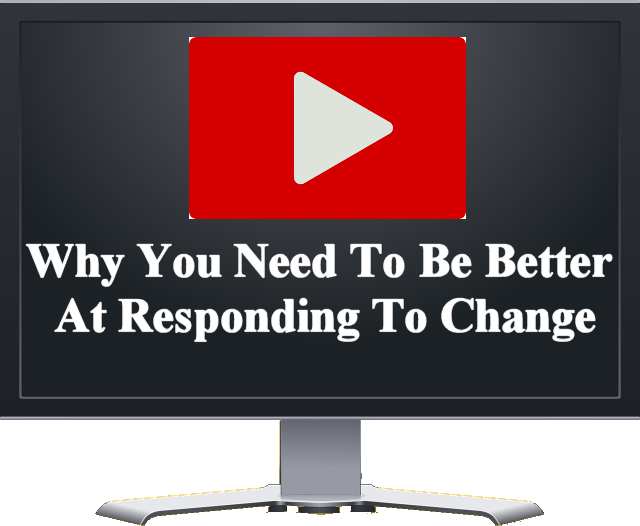One of the advantages of a small business is its ability to change direction quicker than larger corporations. Moreover, the rate of business change continues to accelerate which has given small businesses a leg up on larger corporations.
However far too many small businesses continue to rely on business principles defined long ago when the rate of change was much slower than it is today.
In this video discover what has changed and what you can do as a small business to be more responsive to changes.
This video is just one of 17 lectures in the FREE video course “Applying the Business Model Canvas”
Transcript [lightly edited for clearity]
I want to kind of give a quick bit of background on why things have changed. I’ll be honest with you a year ago I’d had five people in this class today we have over thirty.
There are a lot of things that are changing that make the business model canvas a much more viable way to look at a particular business it’s not to replace the business plan it’s an augmentation to it and I’ll tell you why that fits.
In the old days, we’ve told everybody they had to write a business plan to be able to start a business. It was almost like a rite of passage. If you didn’t go ahead and do a business plan we figured you just didn’t have the moxie or the or what you needed to go ahead.
I write a business blog and recently I talked about the disincentive for actually writing a business plan because the world has changed a lot. So, today we’re talking about the business model canvas because the world changes so fast that we need a different way to address our business models to come up with new ones so here’s what’s changed.
Blue Ocean Strategy. This is a very interesting book and it talks about the blue ocean strategy and how this ties into what I call the long tail economy. It used to be that the only way that you could go ahead and be a success as a business was that you had to have a mass-market product that you could sell to the masses. This is because back then you had an immense amount of expense just to start that business. You had to sell millions of products just to try to make up your startup costs. That’s not the case today.
Today you can buy a 3D printer and make a one-off solution for somebody. The world travels much faster today than it used to. So these are some of the things that change. What the Blue Ocean Strategy is really talking about is saying don’t be in a market where you have a lot of competitors who do exactly the same thing as you. This is a key part of the message because what happens when you’re in that kind of market? You are a commodity, and how do you compete in a commodity market? Price. Not a good place to be.
There are lots of things you can do. Minor little tweaks to a business. Now I’m not trying to say I want to open up a photography business and that Steve is telling me I shouldn’t open that up. I’m saying that’s fine [a photography business] but if you can operate that slightly differently by any one of these millions of tweaks that is what we are talking about here today and that are associated with this business model canvas you in fact can carve out your own piece of blue ocean.
So here is what’s changed. In the old days, we had reasoning skills that I would call causal. These are what I call the General. Let me spin you a yarn and I think you’ll understand exactly what I’m talking about. If you’re a General [in war time] and your objective is to take that particular hill there is a lot of effort that goes into that. It’s not as simple as just charging up the hill. You have to make sure that the manpower is there, you have to make sure the logistics are there, so you have food and ammunition and those kinds of things. You have to come up with a plan of who’s going to do what. Then you gather everybody at the bottom of the hill you assault the hill. But here is the problem. That used to work really great if the enemy was entrenched at the top of the hill in a fortress or something. But today it’s a very mobile world. All the enemy has to do is move from one hilltop to another and when you get to the top of the hill guess what happens. There’s nobody there to fight. Now, what happens? All that time and energy that you spent and all those logistics functions are wasted efforts. That strategy used to work.
That is the same for business. It took a lot of energy and a lot of activity just to go ahead and make that [business] assault happen. It took a lot of expense to do that. Today things happen at a lightning-fast pace. So today what’s valued is what we call effectual reasoning.
If you think about effectual reasoning, it’s like the Explorer, think Christopher Columbus. Christopher Columbus was commissioned to open up the spice trades. He got an Armada of ships and he sailed across the ocean. Guess what happened? He ran into this giant landmass that prevented him essentially from getting to the Spice Islands.
Now if this was a business plan and he had his objective to just get that spice islands he’d have made a left turn and continued to sail around the coastline until he eventually got to the Pacific Ocean and then continue sailing and eventually got to the Spice Islands. But instead, he stopped and looked at the indigenous people and he said, my goodness they have gold everywhere here. I think my employer would be just as happy if I brought home a ship full of gold. So, he changed this plan because he got to a point, made an observation, and pivoted based on what he saw. He never opened up the spice trades, but he did bring back a hold full of gold and a lot of other kinds of things.
So, you may have this idea that says I want to go down this [business] path but halfway down that path, you see new opportunities. It happens and it means certain things have to change. In the old days, I would get funded to reach my stated objective. If I [was Columbus] and ran into this landmass I would have [been forced to turn left to follow the coast and] probably run out of money, food, and supplies before I got there because it [the Americas] was an unanticipated roadblock, a hurdle in my way [to achieving the objective that I was funded to achieve.] that business would have failed.
These are what I’ll call the causal principles:
- I have an expected return
- I want to go after the best possible market
- Maybe I do a competitive analysis to understand where I’m at
- I want to avoid surprises because I want to predict the future
Today we’re talking about effectual principles. Let’s go back to that Explorer example, the first thing is “affordable loss” because I know that if I blow my entire [investment] wad to get to the other side of the ocean like that Explorer [Columbus] and I have nothing left I will not be able to pivot to take a new opportunity. So, the first thing is how much can I afford to lose on this first step because it’s really about the preservation of the capital that I have. So, the lesson is, you don’t want to spend it all [investment capital] right upfront. You want to dole it out because you may need some more capital a little bit later. So, the first principle that’s changed is this affordable loss. It’s not about figuring out an expected return and just going for it, [the affordable loss principle] saying let’s just take baby steps.
Related post; Affordable Loss Principle – Reaching Markets with Minimum Resources
The other principle is what I call strategic partnerships. I’d like to recount a story about one of my mentors you’ve probably never heard of since his name is not a household name but he has a very interesting story and I’m sure you’re familiar with some of his products. So, his name is Ron Muns he used to live in Colorado Springs and he had a software company. He was approached by a company to develop an asset tracking piece of software. Now just to put a time frame on this, it is the period of time when mainframe computers are beginning to give way to PCs. So mainframe computers were very easy to track because they all existed in a raised floor computer lab type of scenario. We didn’t have to track where it was [because they were all in one central place].
Now PCs came along and PCs became distributed across the company. So, this company’s issue was I bought all these PCs and now they’re distributed across my company, I need to understand what desks they’re on, what software they have, what peripherals they have such as a printer, do they not do they have a big monitor or a small monitor or whatever the case may be. So would you like to write this software program so I can track my computer assets?
In the typical world what would happen next is he’d say well I’ll do that for you for a hundred thousand dollars let’s say and then the person would pay him [when it was done]. He would not have a product and would be in the gig economy. [selling time for money] as we call it today, he’d work that job, and then he would look for the next job, and so on and so forth.
But Ron was a smart guy and he said, “Listen before I go ahead and do that [as an hourly project], I’m going to guess that if you have that requirement, some other may also have that same requirement.” So, he went out and found two other businesses that had a similar requirement. He combined all the requirements together and he said, “Listen it’s going to cost $100 grand to build this and I’ll tell you what I’ll charge each of you a third [of the total cost to develop]. It’s a back-office program and it’s not something that differentiates you from your competitors so the businesses said no problem and were more than happy to pay only a third of the cost. Ron added the caveat [because of the reduced cost] that I own the software at the end and I can do with it what I want to. I can sell it to somebody else.
The key part is did he follow the typical model that you see in Silicon Valley where you raise capital to build a product to go ahead and try to sell it? No, he had his customers not only design what functionality they wanted in the program as they were on the tranches and knew what they wanted. Such a program is not something you can just speculate on the functionality, do the development work, and put it out there with the hope it stuck. No the customer who was going to use it to find the product defined it, they paid for you to develop the product and then you owned it. That’s kind of the new world that we live in. It’s called developing strategic partnerships with your customers.
Related Post: Strategic Partnership Principle – The Truth about Competitive Analysis
The other principle is being able to leverage contingencies. So rather than try to predict the future we want to shape the future. So we’re going to go ahead and put something out there [in the marketplace] and then what we’re going to do is we’re going to try to align all the assets to try to make that work.
[Founder entrepreneurs use their effectual reasoning to turn an unexpected result or condition into a profitable end. They plan for the expected, but try not to extend too much in the way or resources just in case they are forced to pivot. Surprises are welcomed as inputs and guideposts to determine if they need to pivot their business venture in what is known as the leverage contingency principle.] The business model is going to change think about Amazon’s business model it’s changing right now.
Related Post; Leverage Contingency Principle – Planning for the Unexpected












